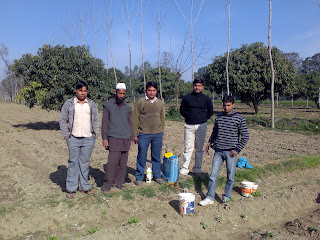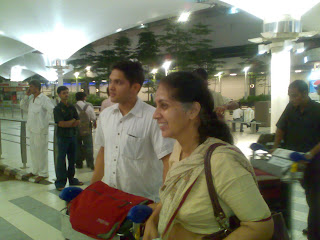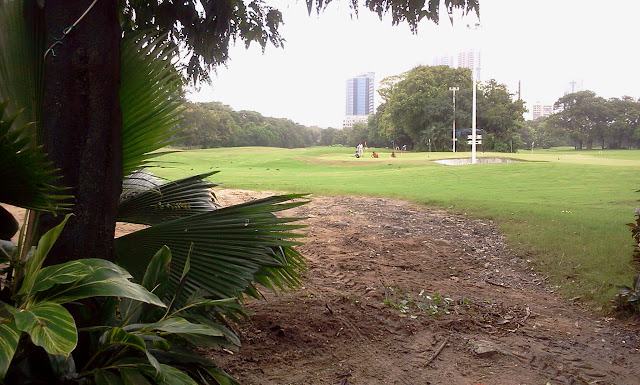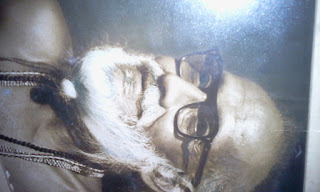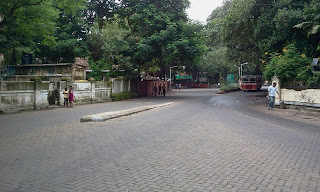My Quest to Know God
experiences in living as a Hindu
Tuesday, November 15, 2011
Saturday, October 15, 2011
Communion
"Do not disturb me".
My Mother's stern and repeated warnings ring in my years, even as I disobey with unremitting love.
She is not entirely without fault in my having to seek communion with her years after she left her mortal body. Firstly, there are many things that I did not learn while she was alive in the conventional sense of the term. Secondly, there have been extenuating circumstances that justified disturbing her eternal peace. Finally, there are times when I simply cannot help myself!
The spirit of my father continues to be more gentle and accommodating. He does not like long sessions in trying circumstances, but is also available for counsel with loads of subtle humor. My vocation does not always allow me to seek communion in the inherited prayer room (pictured above). The practice of mental projection helps my son and I to consult each other though we are now mostly oceans apart, sometimes without electronic connectivity.
My friend and former business associate from Jamnagar (on the western fringe of India) taught me how to communicate unconventionally with a spouse. I have not been able, as yet, to use the technique fully, but he could ask his first and late wife to serve tea by just glancing her way.
Pitaji (my Guru) has been steadfast by my side since he left earth in 1966. He keeps a discreet distance, but never fails to respond quickly and firmly when I need his help.
Communion with God is an incredible resource to float through the turbulent waters of life. A secular way to this end that all of us can use, is to see God in people, other forms of life, and in objects. Casual encounters may titillate some senses, but communion needs deep introspection, time, and persistence. Spend quality time with people you love, like, honor and respect. Discuss issues with them as broadly as possible, focusing on reflective listening, rather than on trying to win debating points. I recall my Mother's peculiar comments on brands of cigarettes ("buy good brands like Benson&Hedges",) though I never openly admitted to smoking.
Communion with people you have never met is not reliable. Historians are not free from bias, so what you read and hear about ancestors and predecessors could be entirely misleading. However, even the briefest meetings with the wise and beloved can be lighthouses in the darkness of difficulties. I have met my paternal grandfather and maternal grandmother only when I was less than 10 years old, yet I know their minds (I think) relatively well. I have tried meditating on pictures and accounts of other ancestors I have never met, and it has worked albeit very gradually.
There may be something in the Hindu convention of communicating with ancestors through crows. Certainly, their actions on occasion can only be explained through imagination of what the departed want, feel, and need. However, it is eternal life that is the Alfonso mango of communion. My wife and son know me so well that I can live adequately through them. Shiben can teach as many of his descendants as possible, so that we can all live forever.
Thursday, September 15, 2011
A Founding Principle for Eternity
"I need to go for a haircut".
Neither Pitaji (my Guru), nor the many women (Mother, elder sisters, and care-taker maid) let me out of their sights. I had to tell them of my whereabouts on a second-by-second basis, in an age without cellphones!
A hair-cut cost some ten rupees in the fifties. Boys less than 10 years old were not expected to give tips. Neither did they have the luxury of doting elders to lessen the burden of sharp scissors around your ears, and those tickly devices on the nape of one's neck.
Buddhi Ayah (the care-taker maid) would supervise my crossing the road, but the rest was up to me. I should say that crossing a road in 1958 was no big deal. It was very much as in Switzerland today. You simply stepped on to a pedestrian crossing, and all automobiles would halt.
Mother gave me the money, many instructions that I forget, while my sisters sternly repeated her words. Buddhi Ayah was mumbling something in the background, but that again was par for the course.
So my final port of call before the hair-cut expedition, was to tell Pitaji. Trust him to come up with something tough!
"I will watch you from our usual place. Report to me on what you observe".
'Usual place' meant the smaller of our two balconies (round balcony is the home jargon). Pitaji loved to sit there. He would engage me in competitions. I had to squat with my hands on my ears if I lost. I never won, so I do not know what he may have done in my place! His favorite was to count cars. Ambassadors and Fiats ruled my city roads in those days. I would have to count Ambassadors as they passed by, while he would count Fiats. The first person to reach a fixed number won. Many decades later, I realized that my city had more Fiats because they were made locally.
Here is a recent picture of the view from the balcony. The road has been divided and the car models have changed (multiplied as well!) Little else has changed over the past half century. The barber shop is in the building next to the white Gothic beauty in the photograph:
"How will I keep count from the barber's shop?"
The question seemed reasonable to me, but it evoked a scornful response from Pitaji.
"Observe inside the shop, not the road, you fool!"
I found this a bid odd as Pitaji could not (I then thought) see inside a barber's shop; in fact, his locks and beard suggested that he had not visited one for long! However, fearing further corporal punishment, I simply kept my mouth shut.
I do not remember crossing the road or the hair-cut. The saloon had the usual motley crowd. I still go there, more than half a century later, and never fail to observe everyone inside as closely as possible! Then, the Spirit of Pitaji and I enjoy a laugh over my observations. They are standard now. A physics lesson in the 1960s taught me again, the same thing that Pitaji did that 1958 day.
I waved to Buddhi Ayah, crossed the road, and went back home with her. I went to Pitaji, after a customer coke and mutton cutlets, and told him everything I thought I had seen in the barber's shop. He listened with unusual patience, but then stumped me as usual.
"What did you see in the mirror while your hair was being cut".
It then struck me that I had seen endless images of everyone between the two mirrors that every barber's shop has, to this day. My physics teacher taught me to observe the same phenomenon by lighting a candle between two mirrors facing each other.
This was my introduction to Advaita or Non-Duality. Pitaji spent the rest of his days with me, ingraining this foundation principle of Hindu philosophy in my psyche. He stepped up the rhetoric even as my mind developed. He also taught me rituals of Narayana worship, havan (homage to fire), and aarati (worship with lights, incense, and bells). However, my doubts about contradictions between these practices and Advaita, dissolved under his benevolent care. I continued to study Non-Duality after he left his mortal form in 1966. The writings of Swami Vivekananda and Dr Sarvepalli Radhakrishnan added substance to my beliefs.
I began studying Biology in 1962, and specialized in this area between 1969 and 1971. My understanding of genetics gave me a secular basis for my commitment to Advaita. All living things have the same nucleic acids. Some scientists believe that life may have come to earth through microbes on the back of asteroids. Certainly, there are bacteria that love stones: I market them!
The concept of Maya (illusion) is more difficult to accept than Advaita. However, the Indian system of Gotra is evidence of the essential unity of all humans. Our species has evolved from humble forms-some of which are still around. Nevertheless, the genetic origins of all life are irrefutably united.
This philosophy has helped me worship Jesus, the Buddha, and the Guru Granth Sahib, even though I remain a practicing Hindu. My pioneering Guru was the first to celebrate the conversion of my eldest sister to the Catholic faith. His Spirit smiled when my son announced that he would marry a Christian. Some of my best friends are Muslims and Zoroastrians.
I revel in Advaita. I hope that my successors will live by it for all time, so that I too can defeat death by living through them.
The photograph below is dominated by vegetation and trees. There is some exposed soil in the foreground that must contain earthworms and microbes. Birds feed on the turf, and there is a dog just beyond the bunker. Poor people earn their bread by looking after this golf course, while their wealthier fellow humans work and live in the tall blocks of concrete and glass on the horizon. Advaita teaches the illusion (Maya) of differences between forms of Brahman (the Universal Spirit).
Monday, August 15, 2011
My Guru
I cannot remember the exact words, but the circumstances of more than half a century ago remain crystal clear in my mind's eye.
My parents, three sisters, and I were out on a drive. We headed South of our home in to the cantonment area of Bombay, as the city was called in the 1950s.
My eldest sister, who not only loves dogs, but who has also imposed her will in this respect on her younger siblings, saw a dog wandering on the road, in the vicinity of the RC Afghan Church.
She demanded of my father that we stop and check on the dog. He had a collar that proved he was not a stray. My eldest sister decided that he must be lost, and that all of us should try and find his family.
Bozo, so named as I found later, knew his way around. He trotted in to a cottage diagonally opposite the Church. We followed him just to make sure that he was not lost.
Pitaji, as we address our Guru, was seated at the far corner of the drawing-room of the cottage. He was seated in a lotus pose, with just a saffron loin cloth.
This miraculous event started a Spiritual journey without end.
The family who occupied the cottage were Bengalis like us. We became friends. The cottage has been replaced by a large building. I have lost touch with the family. However, I remain in constant communion with Pitaji, though he left his mortal form in 1966.
Advaita with all its ramifications abide as Pitaji's cardinal teaching.
Subscribe to:
Posts (Atom)
